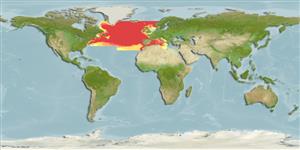Environment: milieu / climate zone / depth range / distribution range
Ecologia
marinhas batipelágico; oceanódromo; intervalo de profundidade 50 - 1032 m (Ref. 56504), usually 200 - 600 m (Ref. 35388). Deep-water; 65°N - 30°N, 77°W - 21°E
Atlantic Ocean: restricted to the North Atlantic and adjacent seas.
Tamanho / Peso / Idade
Maturity: Lm ? range ? - ? cm
Max length : 50.0 cm SL macho/indeterminado; (Ref. 35388)
Depth range from 50-1000 m (ref. 04473) and up to 1032 m in the eastern Ionian Sea (Ref. 56504). Epipelagic to bathypelagic (Ref. 58426); also mesopelagic (Ref. 5951). Feeds on fishes, crustaceans and occasionally planktonic organisms (Ref. 5759). Spawns from March to September, larvae near the surface (Ref. 35388).
Life cycle and mating behavior
Maturidade | Reprodução | Desova | Ovos | Fecundidade | Larvas
Larvae are found near the surface.
Post, A., 1990. Paralepididae. p. 373-384. In J.C. Quero, J.C. Hureau, C. Karrer, A. Post and L. Saldanha (eds.) Check-list of the fishes of the eastern tropical Atlantic (CLOFETA). JNICT, Lisbon; SEI, Paris; and UNESCO, Paris. Vol. 1. (Ref. 4473)
Categoria na Lista Vermelha da IUCN (Ref. 130435: Version 2024-2)
Ameaça para o homem
Harmless
Utilização humana
Pescarias: sem interesse
Ferramentas
Relatórios especiais
Descarregue XML
Fontes da internet
Estimates based on models
Preferred temperature (Ref.
123201): 2.2 - 14, mean 7.4 °C (based on 462 cells).
Phylogenetic diversity index (Ref.
82804): PD
50 = 0.5625 [Uniqueness, from 0.5 = low to 2.0 = high].
Bayesian length-weight: a=0.00224 (0.00090 - 0.00555), b=3.14 (2.92 - 3.36), in cm total length, based on LWR estimates for this (Sub)family-body shape (Ref.
93245).
Nível Trófico (Ref.
69278): 4.1 ±0.70 se; based on food items.
Resiliência (Ref.
120179): Médio, tempo mínimo de duplicação da população 1,4 - 4,4 anos (Preliminary K or Fecundity.).
Fishing Vulnerability (Ref.
59153): Moderate vulnerability (44 of 100).
Nutrients (Ref.
124155): Calcium = 30.6 [9.3, 91.7] mg/100g; Iron = 0.35 [0.11, 1.10] mg/100g; Protein = 16.2 [13.1, 18.8] %; Omega3 = 0.105 [0.028, 0.323] g/100g; Selenium = 21.1 [6.3, 65.8] μg/100g; VitaminA = 11.8 [1.2, 92.8] μg/100g; Zinc = 0.442 [0.227, 0.867] mg/100g (wet weight);
